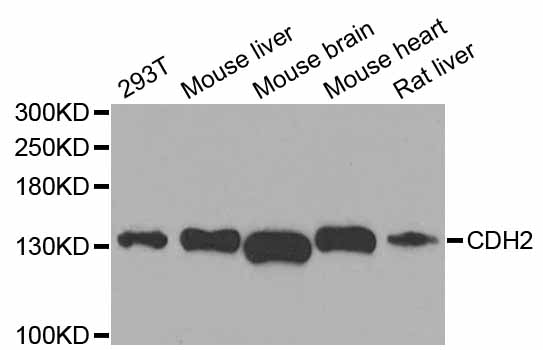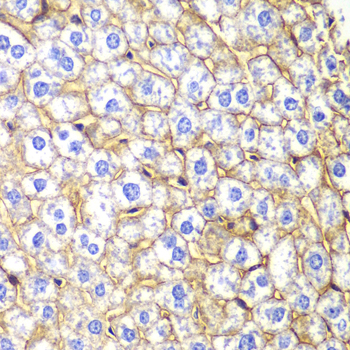Product Name :
N-Cadherin polyclonal antibody Background :
Cadherins comprise a family of Ca2+-dependent adhesion molecules that function to mediate cell-cell binding critical to the maintenance of tissue structure and morphogenesis. The classical cadherins, E-, N- and P-cadherin, consist of large extracellular domains characterized by a series of five homologous NH2-terminal repeats. The most distal of these cadherins is thought to be responsible for binding specificity, transmembrane domains and carboxyterminal intracellular domains. The relatively short intracellular domains interact with a variety of cytoplasmic proteins, such as β-catenin, to regulate cadherin function. Members of this family of adhesion proteins include rat cadherin K (and its human homolog, cadherin-6), R-cadherin, B-cadherin, E/P-cadherin and cadherin-5. Product :
Rabbit IgG, 1mg/ml in PBS with 0.02% sodium azide, 50% glycerol, pH7.2 Storage&Stability :
Store at 4°C short term. Aliquot and store at -20°C long term. Avoid freeze-thaw cycles. Specificity :
N-Cadherin polyclonal antibody detects endogenous levels of N-Cadherin protein. Immunogen :
A synthetic peptide of human CDH2 Conjugate :
Unconjugated Modification :
Unmodification
N-Cadherin polyclonal antibody Background :
Cadherins comprise a family of Ca2+-dependent adhesion molecules that function to mediate cell-cell binding critical to the maintenance of tissue structure and morphogenesis. The classical cadherins, E-, N- and P-cadherin, consist of large extracellular domains characterized by a series of five homologous NH2-terminal repeats. The most distal of these cadherins is thought to be responsible for binding specificity, transmembrane domains and carboxyterminal intracellular domains. The relatively short intracellular domains interact with a variety of cytoplasmic proteins, such as β-catenin, to regulate cadherin function. Members of this family of adhesion proteins include rat cadherin K (and its human homolog, cadherin-6), R-cadherin, B-cadherin, E/P-cadherin and cadherin-5. Product :
Rabbit IgG, 1mg/ml in PBS with 0.02% sodium azide, 50% glycerol, pH7.2 Storage&Stability :
Store at 4°C short term. Aliquot and store at -20°C long term. Avoid freeze-thaw cycles. Specificity :
N-Cadherin polyclonal antibody detects endogenous levels of N-Cadherin protein. Immunogen :
A synthetic peptide of human CDH2 Conjugate :
Unconjugated Modification :
Unmodification
-
 Western blot analysis of extracts of various cell lines, using CDH2 antibody at 1:1000 dilution.
Western blot analysis of extracts of various cell lines, using CDH2 antibody at 1:1000 dilution. -
 Immunohistochemistry of paraffin-embedded mouse liver using CDH2 antibody at dilution of 1:100 (40x lens).
Immunohistochemistry of paraffin-embedded mouse liver using CDH2 antibody at dilution of 1:100 (40x lens).
FOXC2 promotes colorectal cancer metastasis by directly targeting MET
PMCID: Pubmed No.:25381815
A conducive bioceramic/polymer composite biomaterial for diabetic wound healing
PMCID: Pubmed No.:28713016
LncRNA HIF1A-AS2 positively affects the progression and EMT formation of colorectal cancer through regulating miR-129-5p and DNMT3A
PMCID: Pubmed No.:29278853
Ginsenoside Rg3 sensitizes hypoxic lung cancer cells to cisplatin via blocking of NF-κB mediated epithelial–mesenchymal transition and stemness
PMCID: Pubmed No.:29199005
Curcumin inhibits cobalt chloride-induced epithelial-to-mesenchymal transition associated with interference with TGF- β /Smad signaling in hepatocytes
PMCID: Pubmed No.:26302188
Loss of ICA69 Potentiates Long-Lasting Hyperalgesia After Subcutaneous Formalin Injection into the Mouse Hindpaw
PMCID: Pubmed No.:25547463
Tangeretin enhances radiosensitivity and inhibits the radiation-induced epithelial-mesenchymal transition of gastric cancer cells
PMCID: Pubmed No.:25998143
Regulation of the RhoA/ROCK/AKT/β-catenin pathway by arginine-specific ADP-ribosytransferases 1 promotes migration and epithelial-mesenchymal transition in colon carcinoma
PMCID: Pubmed No.:27277835
Paeonol inhibits B16F10 melanoma metastasis In vitro and In Vivo via disrupting proinflammatory cytokines‐mediated NF‐κB and STAT3 pathways
PMCID: Pubmed No.:26452780
HES1 Promotes Colorectal Cancer Cell Resistance To 5-Fu by Inducing Of EMT and ABC Transporter Proteins
PMCID: Pubmed No.:28928869
Overexpressed GRP78 affects EMT and cell-matrix adhesion via autocrine TGF-β/Smad2/3 signaling
PMCID: Pubmed No.:25934251
HES1 promotes metastasis and predicts poor survival in patients with colorectal cancer
PMCID: Pubmed No.:25636905
Gambogic acid suppresses cancer invasion and migration by inhibiting TGFβ1-induced epithelial-to-mesenchymal transition
PMCID: Pubmed No.:28404892
Axon guidance molecule semaphorin3A is a novel tumor suppressor in head and neck squamous cell carcinoma
PMCID: Pubmed No.:26755661
Ginsenoside Rg3 inhibits epithelial-mesenchymal transition (EMT) and invasion of lung cancer by down-regulating FUT4
PMCID: Pubmed No.:26636541
Combining TGF-β1 knockdown and miR200c administration to optimize antitumor efficacy of B16F10/GPI-IL-21 vaccine
PMCID: Pubmed No.:25895132
CircNR3C2 promotes HRD1-mediated tumor-suppressive effect via sponging miR-513a-3p in triple-negative breast cancer
PMCID: Pubmed No.:33530981
Cancer-associated fibroblast (CAF)-derived IL32 promotes breast cancer cell invasion and metastasis via integrin β3–p38 MAPK signalling
PMCID: Pubmed No.:30391782
α-Hederin inhibits interleukin 6-induced epithelial-to-mesenchymal transition associated with disruption of JAK2/STAT3 signaling in colon cancer cells
PMCID: Pubmed No.:29477470
Oroxylin A inhibits the migration of hepatocellular carcinoma cells by inducing NAG-1 expression
PMCID: Pubmed No.:34117368
LncRNA SNHG15 acts as a ceRNA to regulate YAP1-Hippo signaling pathway by sponging miR-200a-3p in papillary thyroid carcinoma
PMCID: Pubmed No.:30237435
Membrane‐tethered Notch1 exhibits oncogenic property via activation of EGFR–PI3K–AKT pathway in oral squamous cell carcinoma
PMCID: Pubmed No.:30515785
Tumor-Educated Neutrophils Activate Mesenchymal Stem Cells to Promote Gastric Cancer Growth and Metastasis
PMCID: Pubmed No.:32903528
Long non-coding RNA Loc490 inhibits gastric cancer cell proliferation and metastasis by upregulating RNA-binding protein Quaking.
PMCID: Pubmed No.:32931453
Migration inhibition of water stress proteins from Nostoc commune Vauch. via activation of autophagy in DLD-1 cells
PMCID: Pubmed No.:30071226
A novel Notch1 missense mutation (C1133Y) in the Abruptex domain exhibits enhanced proliferation and invasion in oral squamous cell carcinoma
PMCID: Pubmed No.:29321718
STAT3-induced upregulation of long noncoding RNA HNF1A-AS1 promotes the progression of oral squamous cell carcinoma via activating Notch signaling pathway
PMCID: Pubmed No.:30404566
The Role of the Tumor Microenvironment in Neuropilin 1-Induced Radiation Resistance in Lung Cancer Cells
PMCID: Pubmed No.:31417646
miR-7-5p acts as a tumor suppressor in bladder cancer by regulating the hedgehog pathway factor Gli3
PMCID: Pubmed No.:30100065
PPARG Negatively Modulates Six2 in Tumor Formation of Clear Cell Renal Cell Carcinoma
PMCID: Pubmed No.:31090452
Pan-Cancer Analysis Identifies CHD5 as a Potential Biomarker for Glioma
PMCID: Pubmed No.:35955624
Bioworld Biotech only provide peptides for our antibodies and do not provide additional peptide customization services.
Price/Size :
USD 368/1mg/vial
Tips:
For phospho antibody, we provide phospho peptide(0.5mg) and non-phospho peptide(0.5mg).Describe :
Blocking peptides are peptides that bind specifically to the target antibody and block antibody binding. These peptide usually contains the epitope recognized by the antibody. Antibodies bound to the blocking peptide no longer bind to the epitope on the target protein. This mechanism is useful when non-specific binding is an issue, for example, in Western blotting (WB) and Immunohistochemistry (IHC). By comparing the staining from the blocked antibody versus the antibody alone, one can see which staining is specific; Specific binding will be absent from the western blot or IHC performed with the neutralized antibody.Formula:
Synthetic peptide was lyophilized with 100% acetonitrile and is supplied as a powder. Reconstitute with 0.1 ml DI water for a final concentration of 10 mg/ml.The purity is >90%,tested by HPLC and MS.
Storage:
The freeze-dried powder is more stable. For short time at 2-8°C. For long term storage store at -20°C.
Note :
This product is for research use only (RUO only). Not for use in diagnostic or therapeutic procedures.
 N-Cadherin polyclonal antibody
N-Cadherin polyclonal antibody  Datasheet
Datasheet COA
COA MSDS
MSDS SHIP
SHIP